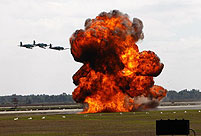WASHINGTON, Nov. 4 -- Injections of large volumes of gas, primarily carbon dioxide (CO2), into the subsurface of a Texas oil field may be linked to a subsequent cluster of small earthquakes, Chinese and U.S. researchers said Monday.
Injecting CO2 into deep rock formations is relevant to the process of carbon capture and storage (CCS), a proposed technique for reducing greenhouse gas emissions by capturing CO2 and injecting it deep underground for long-term storage.
The study, by Gan Wei of China University of Geosciences and Cliff Frohlich of the University of Texas at Austin, focused on an area of northwest Texas with three large oil and gas fields, the Cogdell field, the Salt Creek field and the Scurry Area Canyon Reef Operators Committee unit (SACROC), which have all produced petroleum since the 1950s.
Operators began injecting carbon dioxide in the SACROC field in 1971 to boost petroleum production, a process known as carbon dioxide enhanced oil recovery (CO2 EOR). Operators began CO2 EOR in the Cogdell field in 2001, with a significant increase starting in 2004.
Using a high-resolution temporary network of seismometers, the researchers identified 93 earthquakes in the Cogdell area from March 2009 to December 2010, three of which were greater than magnitude 3. An even larger earthquake, with magnitude 4.4, occurred in Cogdell in September 2011. However, no injuries or severe damage were reported from the quakes.
Using data on injections and extractions of fluids and gases, the researchers concluded that the earthquakes were correlated with the increase in CO2 EOR in Cogdell. They, however, also pointed out that similar rates of injections have not triggered comparable quakes in other fields.
"Our study showed for the first time underground gas injection may cause earthquakes greater than magnitude 3," Gan told Xinhua.
"But there are other fields nearby that have experienced similar CO2 flooding without triggering earthquakes, so further study is needed to better understand why they respond differently to gas injection," Gan said.
The findings were published in the U.S. journal Proceedings of the National Academy of Sciences.
In a paper published last year in the same journal, Stanford University earthquake researchers Mark Zoback and Steven Gorelick argued "there is a high probability that earthquakes will be triggered by injection of large volumes of CO2" during CCS.
"The fact that the different fields responded differently to CO2 injection and that no other gas injection sites in the world have been linked to earthquakes with magnitudes as large as 3 suggest that despite Zoback and Gorelick's concerns, it is possible that in many locations large-volume CO2 injection may not induce earthquakes," Frohlich said in a statement.
The researchers suggested one possible explanation for the different response to gas injection in the three fields might be that there are geological faults in the Cogdell area that are primed and ready to move when pressures from large volumes of gas reduce friction on these faults. The other two fields might not have such faults.
Previous work by Frohlich and others has shown that underground injection of liquids can induce earthquakes.
 Annual airshow kicks off in Houston
Annual airshow kicks off in Houston U.S. Navy Carrier Strike Group stages military exercises
U.S. Navy Carrier Strike Group stages military exercises Volkswagen showcases new energy vehicles in Beijing
Volkswagen showcases new energy vehicles in Beijing  How should we get married nowadays?
How should we get married nowadays?  Commentary:
Commentary: Jakie Chan sees Rubber Duck off in Beijing
Jakie Chan sees Rubber Duck off in Beijing Hello! Horror Halloween Celebration!
Hello! Horror Halloween Celebration!  The catwalk to the world of fashion
The catwalk to the world of fashion  Cruise trip to Taiwan
Cruise trip to Taiwan  Unveil PLA air force base
Unveil PLA air force base  Say goodbye to tube-like apartment building
Say goodbye to tube-like apartment building Oriental education or western education?
Oriental education or western education? China in autumn: Kingdom of red and golden
China in autumn: Kingdom of red and golden National Geographic Traveler Photo Contest
National Geographic Traveler Photo Contest Chinese screen goddesses from Beijing Film Academy
Chinese screen goddesses from Beijing Film Academy Day|Week|Month